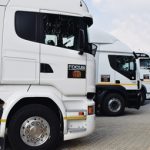That inner drive

GAVIN MYERS puts the power down and (somewhat simplistically) explores what components make up a drivetrain, and how these have changed over the years to become modern-day technical achievements.
It’s probably fair to assume that most commercial vehicle operators have some concept of the inner workings of their vehicles. However, the basic internal combustion engine, and the mechanisms employed to get its power to the road, are in a continual state of flux. The drivetrain is, therefore, a topic that is well worth exploring. So, with an eye on the wider topic, but, where possible, specific to commercial vehicles, let’s do just that …
A vehicle’s drivetrain is made up of all the components that take the power from the powerplant (in this case the diesel engine) to the driven wheels that propel the vehicle. These include the gearbox and transfer box (applicable depending on drive configuration), the propeller shaft/s, and the final drive.
Technically, the powerplant does not fall into the drivetrain category – but it is worth at least taking a high-level look at what exactly makes the power before discussing the drivetrain components.
Engine
Most of the world’s modern-day trucks are powered by diesel engines, which vary in size and power output, depending on the class of vehicle and application for which it will be used. While the basic design of the four-stroke diesel engine has remained unchanged since its invention in the 1890s, ongoing technological advances continually increase power and reliability, while decreasing impact on the environment.
Notable among these was the invention and patent by Cummins, between 1943 and 1946, of the common-rail fuel system (the first successful use of common rail in a production vehicle came in 1995, by Denso with the Hino “Rising Ranger” truck); mass production of turbodiesel trucks by Volvo in 1954; the advent of European emission standards in the 1990s; and the invention of the unit injector system by Bosch in 1994.
While the internal combustion engine will power commercial vehicles for the foreseeable future, a range of alternative powerplants is slowly gaining favour – including full-electric and hybrid (internal combustion and electric) drive.
Gearbox and transfer box
Vehicles (especially heavy ones) require a lot of torque to move and so the gearbox performs a multiplication function by using its various ratios. From the engine, drive (torque) is sent to the gearbox via the clutch (manual/automated-manual/dual-clutch transmissions) or torque converter (automatic transmissions). This is then multiplied by the ratio of the selected gear as it passes from the input shaft through to the output shaft.
At the same time, the output shaft rotates at a rate that is slower than the input shaft, causing a reduction in engine revs and the ability to reach a greater speed. The process is repeated through the following gears.
Here again, technology has moved the game on to levels of efficiency and driver comfort never before imagined. Readers of a more-advanced generation will fondly remember terms like “crash boxes” and “double declutching” … a technique used to match the engine and manual gearbox speeds to allow the gears to engage smoothly.
The widespread advent of synchronisers on manual gearboxes (from the 1980s onwards) did away with this practice and brought about much smoother and easier gear changes for the driver.
Nonetheless, even traditional manual and automatic transmissions are beginning to look antiquated. Thanks to the advent of sophisticated computer control systems, automated manual transmissions (AMT) – whereby the clutch is operated automatically and the driver can (if needed) control the gear selection – are now commonplace in the wider automotive and commercial vehicle world.
Also gaining traction is the dual-clutch gearbox, in which the gearbox internals are split in two; each with its own clutch. Each clutch is, therefore, primed and ready to alternately engage and disengage as and when the next gear change is required. The result is a seamless power delivery – undoubtedly a bonus for a fully loaded rig climbing a hill, as much as it is for a super-quick sports car.
In the case of a vehicle where both the rear and front axles need to be driven (the most basic example being a 4×4), a transfer box, that splits the drive back and forth, is fitted after, or at, the output end of the gearbox.
This function is usually controlled by the driver either manually or, in more recent years, electronically. In some instances, a second set of low-range gears is fitted, which serve to slow the vehicle down and further increase the torque sent to the axles.
Final drive
Once the drive leaves the gearbox and/or transfer box, it is sent along the propeller shaft (prop shaft) to the differential mounted on the driven axle/s (the central shaft connecting the wheels on either side). The differential forms part of the final-drive assembly, which is the last set of components tasked with getting the wheels in motion.
Evidence suggests that differentials have been around, in some form or other, since as far back as 1 000 BC! The modern automotive differential, however, first came into being in 1827 – so there have certainly been many advances on the concept. Nonetheless, the basic differential splits the drive from the prop shaft between the left and right sets of wheels, while also allowing them to rotate at different speeds, aiding turning ability.
Two advancements of the basic automotive differential are the limited-slip (1932) and locking differential (circa 1970s), which are used in applications where the wheels are required to move together and at the same speed (locking) for maximum traction.
Today, many commercial vehicles make use of hypoid gear sets in the differential which – without going into the technicalities – are employed to aid the efficiency and strength of the component.
Commercial vehicles can employ two or more sets of extra tandem axles – which may or may not be driven – in the pursuit of greater traction and weight capacity.
Up to now we have only considered the single-reduction axle (with the single differential that splits and transmits the power), the benefits of which are its light weight and minimal mechanical power losses.
Today, many commercial vehicles, especially those operating in harsh environments, feature hub reduction. This system adds an extra set of reduction gears in the wheel hubs and, therefore, serves to split the final-drive ratio, reducing the load on the differential.
Published by
Focus on Transport
focusmagsa




